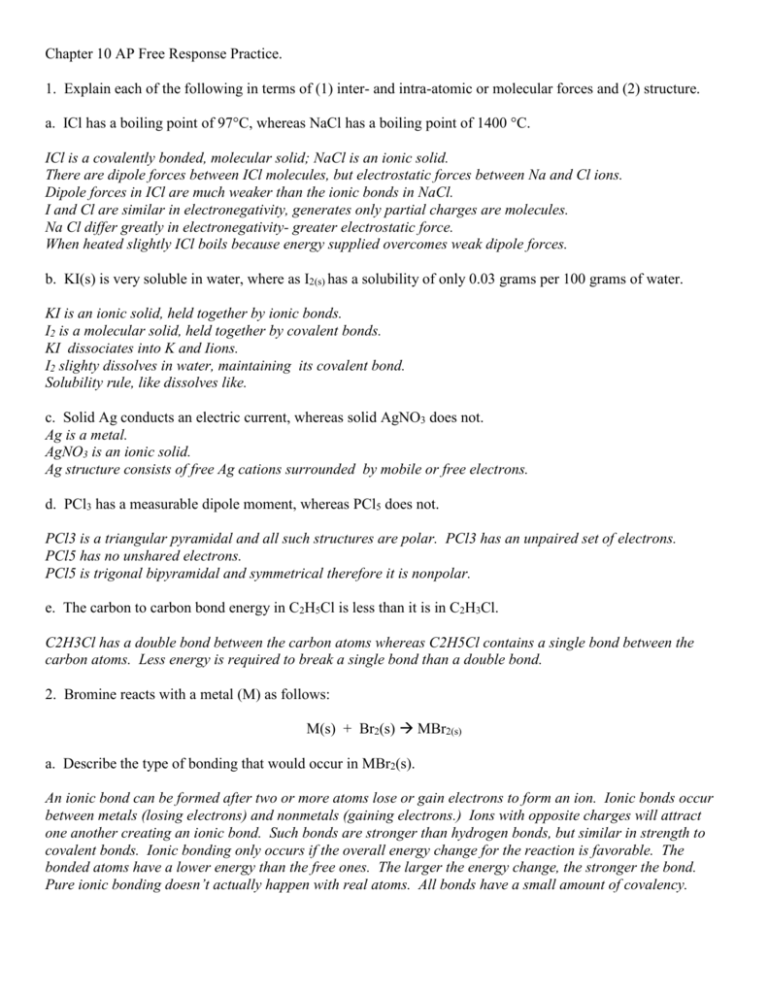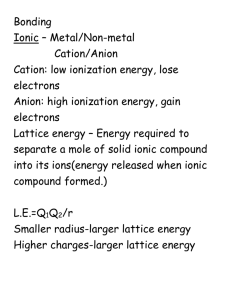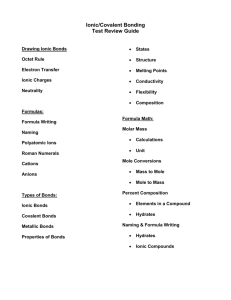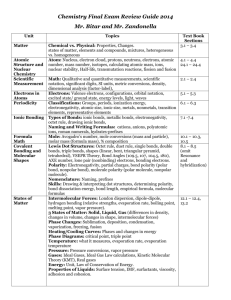Chapter 10 AP Free Response Practice
advertisement

Chapter 10 AP Free Response Practice. 1. Explain each of the following in terms of (1) inter- and intra-atomic or molecular forces and (2) structure. a. ICl has a boiling point of 97°C, whereas NaCl has a boiling point of 1400 °C. ICl is a covalently bonded, molecular solid; NaCl is an ionic solid. There are dipole forces between ICl molecules, but electrostatic forces between Na and Cl ions. Dipole forces in ICl are much weaker than the ionic bonds in NaCl. I and Cl are similar in electronegativity, generates only partial charges are molecules. Na Cl differ greatly in electronegativity- greater electrostatic force. When heated slightly ICl boils because energy supplied overcomes weak dipole forces. b. KI(s) is very soluble in water, where as I2(s) has a solubility of only 0.03 grams per 100 grams of water. KI is an ionic solid, held together by ionic bonds. I2 is a molecular solid, held together by covalent bonds. KI dissociates into K and Iions. I2 slighty dissolves in water, maintaining its covalent bond. Solubility rule, like dissolves like. c. Solid Ag conducts an electric current, whereas solid AgNO3 does not. Ag is a metal. AgNO3 is an ionic solid. Ag structure consists of free Ag cations surrounded by mobile or free electrons. d. PCl3 has a measurable dipole moment, whereas PCl5 does not. PCl3 is a triangular pyramidal and all such structures are polar. PCl3 has an unpaired set of electrons. PCl5 has no unshared electrons. PCl5 is trigonal bipyramidal and symmetrical therefore it is nonpolar. e. The carbon to carbon bond energy in C2H5Cl is less than it is in C2H3Cl. C2H3Cl has a double bond between the carbon atoms whereas C2H5Cl contains a single bond between the carbon atoms. Less energy is required to break a single bond than a double bond. 2. Bromine reacts with a metal (M) as follows: M(s) + Br2(s) MBr2(s) a. Describe the type of bonding that would occur in MBr2(s). An ionic bond can be formed after two or more atoms lose or gain electrons to form an ion. Ionic bonds occur between metals (losing electrons) and nonmetals (gaining electrons.) Ions with opposite charges will attract one another creating an ionic bond. Such bonds are stronger than hydrogen bonds, but similar in strength to covalent bonds. Ionic bonding only occurs if the overall energy change for the reaction is favorable. The bonded atoms have a lower energy than the free ones. The larger the energy change, the stronger the bond. Pure ionic bonding doesn’t actually happen with real atoms. All bonds have a small amount of covalency. b. Define lattice energy. What factors would affect the lattice energy of MBr2(s)? The sum of the electrostatic interaction energies between ions in a solid is called the lattice energy of the solid. By convention, the lattice energy refers to the breakup of a crystal into individual ions. It has a positive value because energy is required to separte the electrical charges. The magnitude of lattice energy is described by Coulomb’s Law LE = Q1XQ2/ r. Lattice energies are largest when the distance between ions is small and when the charges are high. c. If metal M were either magnesium, beryllium or calcium, arrange the possible compounds in order of increasing lattice energies. Explain your reasoning. Within a group or compounds that have the same anion but different cations, the order of lattice energy is the same as the order of increasing cation size. CaBr2 < MgBr2 < BeBr2 3. The boiling points of the following compounds increase in the order in which they are listed below: CH4 < H2S < NH3 Discuss the theoretical considerations involved and use them to account for this order. CH4 is tetrahedrally shaped. It is a nonpolar molecule. The only intramolecular forces are London dispersion forces. A small amount of energy is needed to break the intramolecular bonds. The vapor pressure of this molecule would be high, thus the boiling point would be low. H2S has a bent shaped molecular geometry. It has two sets of lone pair electrons. This created a dipole- dipole moment. The intramolecular bonds are somewhat stronger than the CH3 molecule. NH3 is trigonal pyrimdial and is polar in nature. It also has benefits from hydrogen bonding, the strongest intramolecular force. More energy must be introduced in order to break the bonds between the molecules and create a vapor pressure equal to the atmospheric pressure.








